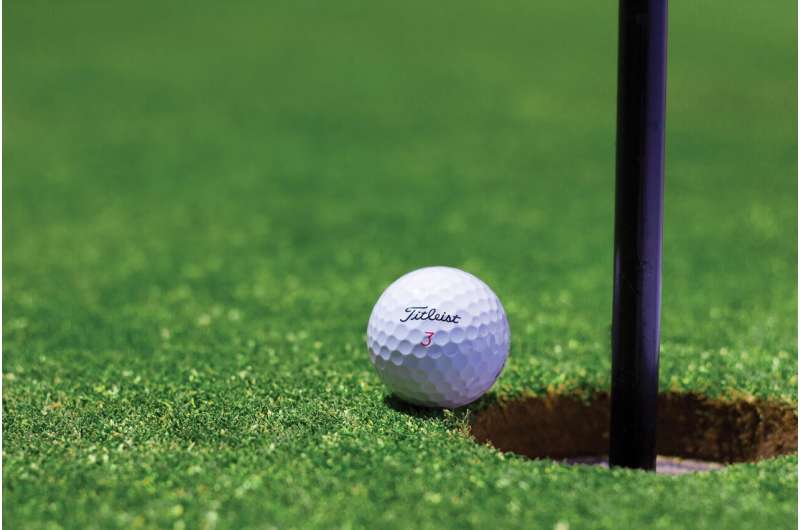Science
Researchers Uncover Physics Behind Golf’s Frustrating ‘Lip Out’

Golf can deliver moments of both triumph and frustration, none more so than when a putt seems destined for the hole only to bounce back out. This phenomenon, known as the “lip out,” has puzzled players at all levels. New research from the University of Bristol delves into the physics that dictate this cruel twist of fate, revealing insights that could help golfers adjust their technique.
Emeritus Professor John Hogan led the study, which has been published in Royal Society Open Science. He refers to the golf balls that fail to drop as “the golf balls of death,” drawing an analogy to motorcycle riders performing the circular “wall of death” stunt. The research outlines two distinct types of lip outs: the rim lip out, where the ball does not fall below the green’s surface, and the hole lip out, where it does.
At the core of both lip outs is a concept known as “degenerate saddle equilibria.” This describes the precarious balance of a golf ball perched on the rim of the hole. It is neither fully in the hole nor safely resting on the green. The rim lip out occurs when the ball rotates around the rim at a fixed angle and velocity. Minor disturbances, such as a grain of sand or a puff of wind, can determine whether the ball falls in or rolls back onto the green.
In contrast, the hole lip out happens under specific conditions. Professor Hogan explains that when the ball falls into the hole, it engages in a pendulum-like motion, converting its potential energy into spin. Provided it does not touch the hole’s bottom, it can rebound back to the rim and roll away.
So how can golfers avoid these frustrating lip outs? Professor Hogan offers practical advice. He suggests that players should aim as close to the center of the hole as possible while approaching the rim at low speed. “This combination means that the small amount of momentum the ball has is just enough to tip it into the hole, rather than carry it around the rim and back out,” he said.
Professor Hogan’s research builds on his previous work applying the principles of mechanics to sports. He has explored the physics of skateboarding and the dynamics of basketballs after hitting the hoop. By using the laws of motion originally described by Sir Isaac Newton, he demonstrates how these principles can illuminate the intricacies of various sporting actions.
This investigation into the lip out phenomenon not only enhances the understanding of golf mechanics but also highlights the broader application of physics in sports. As golfers seek to refine their skills, understanding the science behind their game may be as crucial as practice itself.
For those interested in the technical details, the study offers an in-depth look at the mechanics involved in these frustrating occurrences on the green.
For more information, refer to the study published in Royal Society Open Science (2025).
-

 World3 weeks ago
World3 weeks agoGlobal Air Forces Ranked by Annual Defense Budgets in 2025
-

 World3 weeks ago
World3 weeks agoMass Production of F-35 Fighter Jet Drives Down Costs
-

 Science3 weeks ago
Science3 weeks agoTime Crystals Revolutionize Quantum Computing Potential
-

 Top Stories3 weeks ago
Top Stories3 weeks agoNew ‘Star Trek: Voyager’ Game Demo Released, Players Test Limits
-

 Top Stories3 weeks ago
Top Stories3 weeks agoDirecTV to Launch AI-Driven Ads with User Likenesses in 2026
-

 World3 weeks ago
World3 weeks agoElectrification Challenges Demand Advanced Multiphysics Modeling
-

 Entertainment3 weeks ago
Entertainment3 weeks agoFreeport Art Gallery Transforms Waste into Creative Masterpieces
-

 Lifestyle3 weeks ago
Lifestyle3 weeks agoDiscover Reese Witherspoon’s Chic Dining Room Style for Under $25
-

 Health3 weeks ago
Health3 weeks agoGavin Newsom Critiques Trump’s Health and National Guard Plans
-

 Lifestyle3 weeks ago
Lifestyle3 weeks agoLia Thomas Honored with ‘Voice of Inspiration’ Award at Dodgers Event
-

 Entertainment3 weeks ago
Entertainment3 weeks agoFast & Furious Coaster Hits the Track at Universal Studios
-

 Health3 weeks ago
Health3 weeks agoResearchers Uncover New Insights into Cancer Mortality Causes









